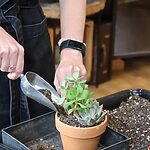☀️ Light
☀️☀️▫️ (Medium)
The Variegated Kalanchoe Daigremontiana Pink Butterfly thrives in bright, indirect light. It can also adapt to direct sunlight but be cautious of too much direct exposure which might scorch its leaves. A spot near a window with a sheer curtain is ideal for this vibrant succulent.
💧 Water
💧💧▫️ (Medium)
This succulent prefers a ‘soak and dry’ method for watering. Allow the soil to completely dry out between waterings. Overwatering can lead to root rot, so ensure the pot has good drainage and only water when the soil feels dry to the touch.
🌡️ Temperature
🌡️🌡️▫️ (Average)
Variegated Kalanchoe Daigremontiana enjoys typical indoor temperatures ranging from 15°C to 25°C. Keep it away from draughty areas and protect it from frost, which can be harmful to the plant.
💧 Humidity
💧▫️▫️ (Low)
Being a succulent, the Pink Butterfly prefers lower humidity levels. Typical room humidity is sufficient, and there’s no need for any extra humidity adjustments.
🌱 Repotting
Repot your Kalanchoe every 2-3 years or when it outgrows its pot. Use a well-draining succulent mix to ensure healthy growth. Spring is the best time for repotting, giving the plant a fresh start with more room to grow.
🐾 Pet Friendliness
Caution is advised as Kalanchoe plants can be toxic if ingested by pets. Keep it out of reach from curious cats and dogs to avoid any mishaps.
🏠 Recommended Locations at Home
Perfect for sunny desks, shelves, or south-facing windowsills. Its striking appearance also makes it a great centerpiece for dining tables or bright bathrooms.
🌿 Air Purifying
While not specifically known for air-purifying properties, like all plants, it contributes to a reduction in indoor pollutants to some extent.
✨ Other Plant Features
The ‘Pink Butterfly’ is not only visually stunning but also fascinating due to its prolific propagation abilities. It’s perfect for those who enjoy sharing plants, as the baby plantlets can easily be propagated and given to friends and family.
Remember, if you have any more questions about caring for your Pink Butterfly, you can ask Mossbot for help, contact us via our website, or take advantage of our free plant hospital service for additional assistance!
 Variegated Kalanchoe Daigremontiana Pink Butterfly
Variegated Kalanchoe Daigremontiana Pink Butterfly






















Reviews
There are no reviews yet